Affordable analog Synthesizers have been a reality for some years and continue to be a big topic in the music world. Nearly 6 years ago, ARTURIA impressively demonstrated this with the MiniBrute. An analog monophonic Synthesizer with a very own sound and enough features for a fair price. A lot has happened in these 6 years and almost every important music company that deals with electronic music has an affordable analog Synthesizer on the market (KORG, Novation, Moog Music, Pioneer DJ…). Six years have passed in which the French company released several analog brute products: MiniBrute, MicroBrute, MatrixBrute and DrumBrute.
Now it’s time to retire the MiniBrute and present a true modern successor that does not just consist of a cosmetic update. After a long development, ARTURIA announced today the MiniBrute 2, the next generation of the best known analog monophonic Synthesizer. One thing stays the same: the MiniBrute 2 still does not have a preset browser. So all the sound changes are at your fingertips.
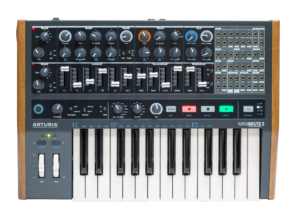
The ARTURIA engineers expand in the new MiniBrute 2 the entire engine with interesting new features while maintaining the unique and best known sound character. In addition to the powerful voice architecture the MiniBrute 2 provides a 48-point patch-bay, which allows you to bypass any pre-conceived notions regarding the signal path. Now you can bring in control signals and audio from the outside world and patch them into the MiniBrute 2 circuitry. This open-ended approach to sound design will open sonic doors you.
ARTURIA MiniBrute 2 – An All New Design
What you will notice immediately is the new design of the new MiniBrute.
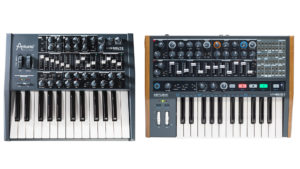
If you compare it with the old one, then the device was stretched a bit wider and designed more modern. The MiniBrute 2 now has wooden side panels and new color accents in the filter, amp and in the sequencer section. Also, the pitch and modulation wheels have been moved from top left to bottom, which is a very good decision.
Sound Engine: 2nd Oscillator, FM & More
Yes, the signal path is still full analog but on of the biggest difference compared to the first MiniBrute are the number of oscillators. The MiniBrute 2 now comes with two multi-waveform oscillators. VCO1 comes with a sawtooth, square and triangle waveform and each waveform has its own wave-shaper. Using the sawtooth waveform, users can apply the Ultrasaw shaper function that consists of two copies of the plain saw that are independently phase-shifted using LFO2.
The square wave form can me modified by a classic pulse width modulation and the triangular by the metalizer shaping function best-known from the Brute Synthesizers. The Metalizer takes the peaks of the basic triangular waveform and “folds” them downward to create very complex jagged waveforms that are rich in high harmonics This knob affects all three waveforms of VCO 1 at the same time. It’s also possible to modulate the Metalizer shaper function with the metal mod knob.
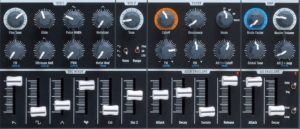
The second oscillator is here one of the big news over its predecessor and allows many new sounds. The second oscillator features a sawtooth, square and sine waveform. It can be used as classical oscillator but also as LFO. With the help of the second sound generator, it’s now possible to create frequency modulation between oscillator 1 and 2. On the left side, you have a dedicated knob for creating very straightforward FM sounds. As with the first MiniBrute, its possible to combine the individual waveforms in the mixer and mix them perfectly together. In this section, you can find also a noise generator as well as an slider for the amount of the external input.
Sound Engine: The Steiner-Parker Filter With FM & RM
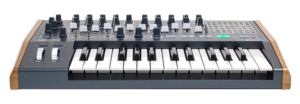
Sound Engine: New Envelopes Features
It’s not just a simple AD envelope but has various other features. Users can change here the function of it with a switch to gate or trigger. Beside this, users can choose between the once and loop function.
-
-
Once: When a note is played/triggered the amplitude rises from zero at the Attack rate and returns to zero at the Decay rate.
-
Loop: When the envelope reaches the end of the Decay stage it will start over from the beginning. It will continue to loop
-
Sound Engine: 2 LFO’s For More Modulations
The MiniBrute 2 provides now two LFO’s, each with waveforms choices of sine, triangle, sawtooth, square and two types of random waves. Each LFO has its own wave selector and rate control knob, a switch that determines whether it will run freely or synchronise to the master clock. The LFO’s range here from 16 seconds (0.0625Hz) up to fast rates (100Hz). There is also a secondary shift function for each LFO that lets you decide if you want an LFO to retrigger when a new note is played. It’s also possible to use the second oscillator as third fully functional LFO.

Sound Engine: New Advanced Amp Section
The engineers also changed a bit the amplifier section. Same as in the MiniBrute v.1, the new version comes with the great Brute Factor that is inspired by a common patch used on a famous vintage mono Synthesizer that connected the headphone output to the external audio input. The result is a kind of feedback loop that’s ideal for raspy and grungy sounds. New in this section is a second attenuator features that is routed to the amplifier which accessible on the new patch-bay.
Sound Engine: An All New Modular Patch-Bay ” Release The Beast”
In addition to the powerful voice architecture the MiniBrute 2 provides a 48-point patchbay, which allows you to bypass any pre-conceived notions regarding the signal path. Now you can bring in control signals and audio from the outside world and patch them into the MiniBrute 2 circuitry. This open-ended approach to sound design will open sonic doors you never knew were there.
With the new patch bay, the MiniBrute 2 grows up and opens its sound engine almost completely. Here, the individual sound elements such as oscillators filters, envelopes, LFO can easily tap into and integrate nicely into modular systems. It often happens that you are facing jacks and don’t know if it’s an input or an output. The ARTURIA engineers solved this problem in a different way.

The connectors in the MiniBrute 2 patch bay fall into two main categories: inputs and outputs. It is easy to know which is which: The output jacks are labeled with white boxes containing text or graphics, and the input jacks only have words under them. A white line is drawn around certain groupings of input/output jacks. This indicates which connections are related to which MiniBrute 2 components
In this patch-bay you have access to all functions of the synthesis as well as the new arpeggiator and sequencer. So you can very quickly connect the synth to a modular system and build unheard Brute sounds.
New Arpeggiator & Sequencer Section
MiniBrute 2 provides all-new sequencer and an arpeggiator not available on the previous version. You can record & store eight different sequences, each with up to 64 steps. The arpeggiator generates notes based on the keys you have pressed and plays them back according to the setting of the Seq / Arp Mode knob.

As usual for modern ARTURIA products, you have two ways to enter a sequence: while the sequencer is running or in the stop mode. An amazing feature of the sequencer is that you it allows you to record or replace the notes in a sequence while it plays. The build-in arpeggiator is also not a simple one but features many different operation modes: up, down, inclusive, exclusive, random order, up 2x, down 2x. Both expanded features offers musicians now a lot of sequence possibilities.
New Key-Bed With Velocity & Aftertouch
New in the MiniBrute 2 is also a massive improved key-bed with good new features. It provides a two-octave, piano-type keyboard and provides additional control for adding expressiveness to your sounds. It features now support for aftertouch (how hard you press on a key) and velocity. Two amazing new features that gives far more creative ways to play an analog monophonic Synthesizer
Backside Connections
Compared to the MiniBrute 1 there are clear differences on the back.
So there is no longer a large jack input as audio input but only now a master output, headphone out, MIDI In / Out, USB port and a power supply connector with On / Off switch.
All Features At Glance
- Fully analog signal path
- 2 multi-waveform voltage-controlled oscillators (VCOs)
- VCO1: Sawtooth, square, and triangle waveforms (VCO 1)
- Ultrasaw, Metalizer, and pulse width modulation (PWM)
- VCO2: Sawtooth, square, and sine waveforms
- FM modulation between oscillators
- Random noise generator
- Steiner-Parker multimode filter with FM and RM (Resonance Modulation)
- 48-point patchbay
- Hard sync input for VCO1
- Separate VCA for modulation routings
- Two envelopes: ADSR (filter) and AD (amplitude)
- Loopable AD envelope
- Two multi-waveform LFOs with free-run or sync modes
- Brute Factor: overdrive the filter input with the audio output
- External audio can be routed through the Oscillator mixer or directly to the output
- Sequencer and arpeggiator, syncable to external clock: MIDI, USB, or CLK (1 step, 1 pulse, 24/48 ppq)
- MIDI input and output connectors
- USB port for use with a DAW
- Audio and headphone outputs
- Use with Arturia’s MIDI Control Center for device configuration and sequence archival
First Look Video By BoBeats
The new MiniBrute will be available in April 2018 for a price of 649€.
More information here: ARTURIA MiniBrute 2



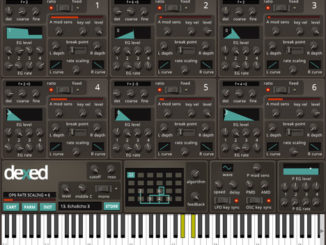
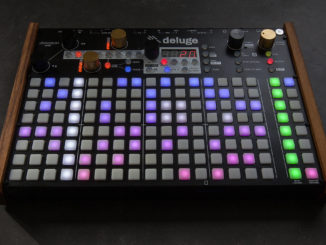
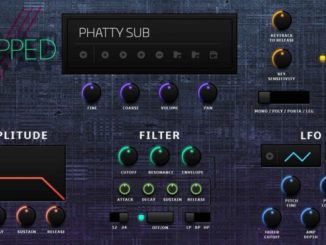
Be the first to comment